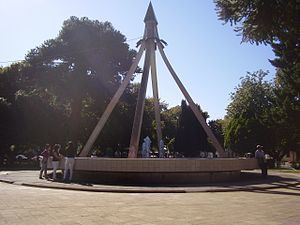Elevation 80 m (260 ft) Area 760.4 km² | Region Biobío Founded January, 1558 Demonym(s) Cañetino Local time Tuesday 1:32 AM Number of airports 1 | |
 | ||
Weather 12°C, Wind E at 5 km/h, 86% Humidity | ||
Cañete is a city and commune in Chile in Arauco Province, Biobío Region. It's located 135 km to the south of Concepción. Cañete is known as the "Historic City" (Spanish: ciudad histórica), due it is one of the oldest cities of Chile, the Battle of Tucapel and Pedro de Valdivia's death happened near the current city's ubication, and has been a recurrent place in Arauco War.
Contents
- Map of CaC3B1ete BiobC3ADo Chile
- Etymology
- Fort Tucapel
- Caete de la Frontera
- Refounding
- 21st century
- Demography
- Administration
- Transport
- Museums
- Rural culture
- Movies
- Notable people
- References
Map of Ca%C3%B1ete, Biob%C3%ADo, Chile
Etymology
Cañete was founded by Governor García Hurtado de Mendoza as Cañete de la Frontera, in honor of his father, Andrés Hurtado de Mendoza, 3rd Marquis of Cañete. His title was originated by villa Cañete, in Crown of Castile.
Before the founding, the place was known as Tucapel, which means taking by force in Mapudungun.
Currently, Cañete is known as the Historic City (Spanish: ciudad histórica) by mass media.
Fort Tucapel
In 1552, Pedro de Valdivia founded the Fort Tucapel, next to the present city of Cañete. In 1553, after destroying the fort, the native Mapuche defeated the Spanish army here in the Battle of Tucapel, and killed Pedro de Valdivia.
Cañete de la Frontera
In January 1558, Governor García Hurtado de Mendoza founded the city as Cañete de la Frontera three kilometers to the west of the present location of the city. Hurtado de Mendoza named Alonso de Reinoso as corregidor of the Corregimiento of Cañete. The Mapuches, leadered by Caupolican, besieged the city, but were defeated in the battle of the Fort of Cañete.
Disastrous military defeats forced governor Francisco de Villagra to order the city to be abandoned in January 1563. A new foundation of the city, ordered by Rodrigo de Quiroga in 1566 did not prosper either due to the constant attacks by the Mapuche.
Refounding
The present city was founded on 12 November 1868 by colonel Cornelio Saavedra Rodríguez as part of the pacification of Araucanía.
21st century
In November 12, 2006 a car accident happened near the town of Canete. A bus fell into the River Tucapel with dozens of people inside. Most of them were soldiers, musicians of the instrumental band Reinforced Regiment No. 7 "Chacabuco" Concepción, who went to the anniversary of the commune of Cañete. The accident was named as the tragedy of Cañete by press, like the tragedy of Antuco. President Michelle Bachelet, the minister of National Defense Vivianne Blanlot and Commander-in-Chief Óscar Izurieta were at the funerals in Concepción.
The 2010 earthquake caused several damages in the city, as in the construction of hospital Kallvu Llanka, whose inauguration was scheduled for October 8 of that year. Due to the delay of the building, this date was postponed for 2011. Finally, the hospital was inaugurated on October 22, 2013.
Demography
According to the 2002 census of the National Statistics Institute, Cañete spans an area of 760.4 km2 (294 sq mi) and has 31,270 inhabitants (15,625 men and 15,645 women). Of these, 19,839 (63.4%) lived in urban areas and 11,431 (36.6%) in rural areas. The population grew by 6.6% (1,947 persons) between the 1992 and 2002 censuses.
Projections indicated that the population in 2009 was 33,535 inhabitants.
Administration
As a commune, Cañete is a third-level administrative division of Chile administered by a municipal council, headed by an alcalde who is directly elected every four years. The current alcalde is Abraham Silva Sanhueza (PDC), and the council currently consists of the following members: Verónica Alicia Sandoval (RN), Ana María Fierro (PDC), Luis Adrián Viveros G. (PRSD), Mario Lobo Bueno (PRSD), Óscar Leal Aravena (PRSD), and Cristian Medina Cea (UDI). The municipality of Cañete is a member of the Association of Municipalities of the Arauco Province, also known as Arauco 7.
Within the electoral divisions of Chile, Cañete is represented in the Chamber of Deputies by Manuel Monsalve (PS) and Iván Norambuena (UDI) as part of the 46th electoral district, (together with Lota, Lebu, Arauco, Curanilahue, Los Álamos, Contulmo and Tirúa). The commune is represented in the Senate by Víctor Pérez Varela (UDI) and Felipe Harboe Bascuñán (PPD) as part of the 13th senatorial constituency (Biobío-Coast).
Transport
In northern Cañete is located Las Misiones Airport.
Museums
The Mapuche Museum of Cañete has been located in the southern part of the city since 1968.
Rural culture
Between January and February of each year, the Agricultural, Livestock and Forestry Fair of Cañete (Spanish: Feria Agrícola, Ganadera y Forestal), also known as FAGAF, is performed on the farm Anike, two kilometers from the city. This fair is considered the largest in the south and one of the most important in Chile. The fair usually has more than one hundred exhibitors related to the culture of the area, mixing Mapuche and farmer traditions and activities such as loose mare threshing, agricultural and forestry machinery exhibitions, gastronomy contests, and others. Since 2015, the fair is held in conjunction with the Cañete Week, and presentations of singers, music groups and comedians.
Also, the Farmer Fest of Cayucupil, takes place in the rural area located 14 km from the city center.
Movies
The importance of movies in Cañete is growing, the city is a headquarter of the Lebu International Film Festival. Jorge Olguín's 2014 movie Whispers of the Forest was filmed around Cañete, mainly in Reussland Park –near Peleco–, and Morales Castle, 10 km north of the city.
